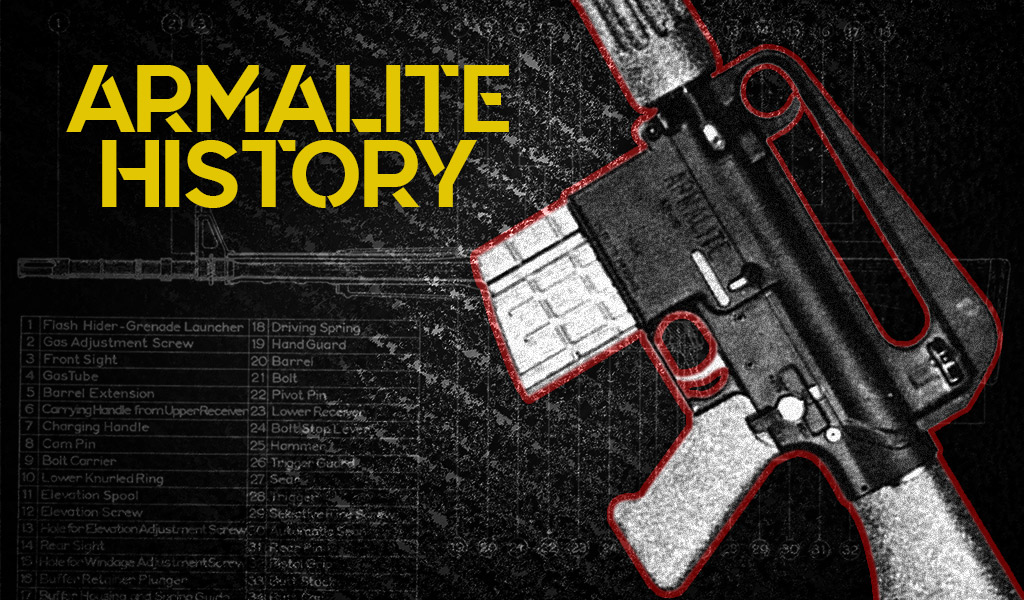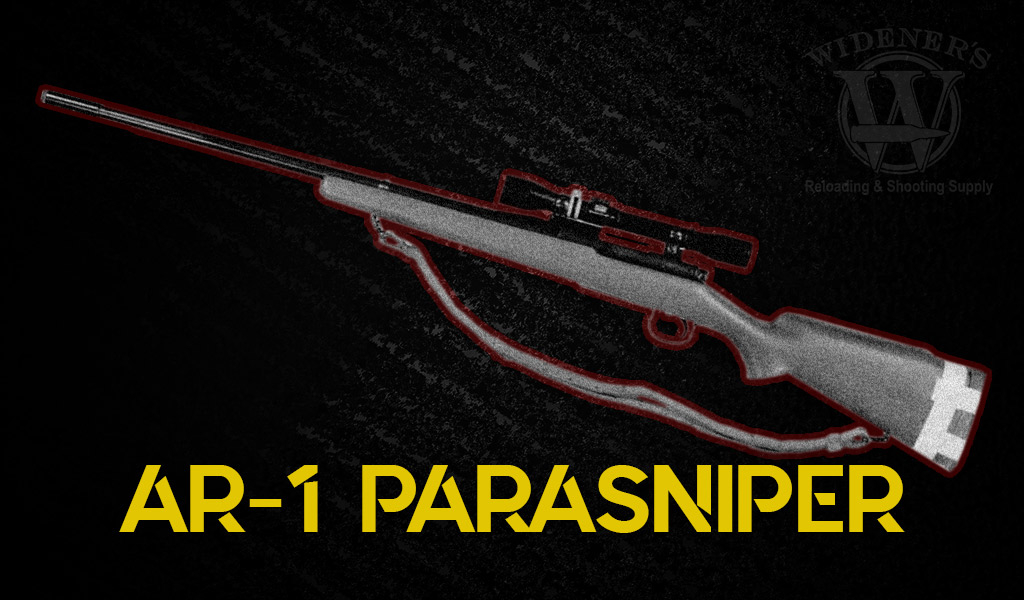

ArmaLite weapons are synonymous with AR-pattern rifles, which have been ironically coined as ‘Modern Sporting Rifles’ (MSF). Why the irony? The AR-10 which was the precursor to the MSF, was designed in 1955. To put things in perspective, McDonald’s opened in 1955, as did Disneyland. James Dean infamously died that year at age 24, and ABC aired the first episode of Gunsmoke. The AR is as American as the ’55 Chevy and apple pie. Despite being a true American classic, the AR platform is a dated mid-century creation at best. Let’s dive into Armalite rifle history and its significance to shooting culture.
How did ArmaLite become an important part of our history? We all know that Eugene Stoner created the AR-10, and later the AR-15 for ArmaLite. But what happened that ultimately caused ArmaLite to sell the patents to Colt? Is ArmaLite a one-trick pony with nothing more than gas impingement in their inventory? Not by a mile. Maybe five miles. Let’s take a look at ArmaLite, who they were, who they are in the present, and what happened along the way.
ArmaLite: Inception and Early Years
The interesting thing about ArmaLite is that it did not come about as an organic small arms or firearms manufacturer. Rather, ArmaLite came into being as the brainchild of Richard Boutelle, president of the Fairchild Engine and Aircraft, the same Fairchild who would later create the infamous A-10 Warthog (I’ll not insult it by using its given name of Thunderbolt II). The company never meant to serve as a small arms manufacturer. It intended to do what it ultimately did with the AR-15: design and patent weapons and sell design rights, which it did.
What Does ‘AR’ Stand For?
The AR-1 Parasniper was the initial project of the brand, with ‘AR’ standing for ‘ArmaLite Rifle’. It was a lightweight bolt-action survival rifle designed for Air Force aircrews, but it never got out of the prototype phase. But even though it never went beyond the drawing board, the AR-1 was a very important step towards the weapon which would ultimately define the company. The AR-1 implemented a foam-filled fiberglass stock, which is very light, very strong, floats, and does not warp. This was a major step away from traditional methods of construction and is still used on the AR-7 today.
Speaking of the AR-7 survival rifle, let’s have a look at the original ArmaLite survival rifle, the AR-5. Chambered in the .22 Hornet, the U.S. Air Force briefly adopted it as the MA-1. It was intended to serve as a survival rifle for aircrews on the XB-70, a fantastic bomber that never made it out of the gate. The AR-5 was a super-lightweight bolt action rifle that weighed in at only 2 ½ lbs. and only about 2 ½’ in length as well. The .22 Hornet is still around, but never really took off because the rimfire .22 WMR is so close in ballistics. It is still a potent offering that gave potential downed aircrews a weapon much more capable than the .22LR.
Familiar Territory: The AR-10
ArmaLite was focusing its energy at the M1 Garand replacement in the mid-1950s. The 7.62x51mm was in the final stages of replacing the potent .30-’06, and the Garand was leaving with it after a fantastic career. The frontrunner to the Garand was, well…basically another Garand. The M14 (T44 in testing) competed for the top spot and ultimately won, although that would be very short-lived. Eugene Stoner was hard at work designing a contender for the project, the AR-10.
It was a radical design, straying far from the traditional gas-operation of the M1 Garand and M1 carbine. His design utilized a revolutionary gas impingement system and enlisted the use of radical new techniques and materials. The AR-10 did away with traditional wooden furniture in use on all military rifles. Instead, its design favored plastics which saved considerable weight. The lack of an external bolt handle allowed the rifle’s chamber to be closed off by use of an ejection port cover. Modern AR-pattern rifles widely use this design to this day.
M-14 Battle Rifle
Ultimately the M14 won the day and was adopted as the main battle rifle in 1959, but it would be very short-lived. The rifle was deployed in the early years of Vietnam, where the 7.62x51mm was valued for its ability to penetrate jungle foliage with ease. While the Garand had been fabulous in temperate Western Europe, the traditional wooden stock of the M14 failed almost immediately in the suffocating heat and humidity of Vietnamese jungles. Since the jungle foliage is impenetrable by traditional modes of conveyance, long foot patrols were the standard for the duration. The heavy M14 was cumbersome in this environment, as it is also a rather long weapon at over 44” in length, and hefty at nearly 11 lbs. with a loaded magazine.
ArmaLite Weapons: Defining the Modern Era
Eugene Stoner had designed a winner in the AR-10, but it was just not quite right on timing. After Vietnam commenced it became apparent that the M14 was not well suited for the environment. Soldiers complained it was uncontrollable when operated in full-automatic fire. Also, the 7.62x51mm ammunition was too heavy for soldiers to carry in bulk. This made it difficult to engage in sustained fire with enemy combatants who were carrying the much lighter but still potent AK-47 rifle.
The M1 carbine has been a very popular weapon during WWII, due to its ease of handling, durability, and being lightweight. So popular, in fact, that the military introduced a select-fire variant during the Korean War, the M2. While the M2 solved the problem of ammunition weight, weapon weight, and controllability, the straight-walled .30 carbine cartridge is seriously outclassed by the punchy 7.62x39mm which held a 500fps advantage on the carbine.
Colt Makes A Purchase
By the early- to mid-1960s, the U.S. was embroiled in a serious ground conflict in Vietnam. This war could not be won with Cold War technology and tactics. It would be a battle of small skirmishes and long forced marches. Ironically, the future standard issue rifle for decades, the M16, was developed and submitted to the Army nearly a decade prior to Vietnam. It was unilaterally benched by General Maxwell Taylor in favor of the M14. ArmaLite, as ingenious as they were, simply did not possess the deep pockets to sit on a design forever so they sold the rights of both the AR-10 and AR-15 to Colt.
Eugene Stoner’s Genius
While we could go on with ArmaLite’s history post-AR, this seems to be a disservice to the design. The incredible success and staying power of the platform is a direct testimony to Mr. Stoner’s ingenuity, and the sheer genius of the design. What more can you say? The AR-pattern rifle has been the standard duty rifle of the U.S. military for over 50 years. The only small arm in history which is comparable is the Kalashnikov AK-47 pattern rifle. It was designed in 1946, but has been in service for about the same amount of time.
Think Mustang and Camaro. While both have seen myriad adjustments and improvements, nothing else even comes close in terms of versatility, particularly the Stoner design. The Kalashnikov has proven durable to almost unreal lengths, but not particularly versatile. The AR-pattern is very durable, but the versatility is unbelievable. The ability to change calibers at will by doing little more than pushing a couple of pins and plugging in a separate upper receiver, and maybe bolt carrier group and magazines.
ArmaLite Design: Beyond The AR-15
While the direct impingement design by Mr. Stoner is by far the most prolific design of ArmaLite, it was not the only good design. A contemporary of the AR-10/15 pattern rifles were the AR-16 and AR-18 models. Mr. Stoner also designed these models.
In the post-Korean War era, it was quickly becoming clear that the heavy rifle calibers like the 7.62x51mm, .30-06 Springfield, and 7.62x54r were becoming a thing of the past. The landscape of battle was changing, and armies were taking a more modular approach to weapon systems. ArmaLite had since sold off the rights to the AR-10 and AR-15 platforms to Colt in 1959, but recognized the newfound potential in offering a compact battle rifle in the 5.56x45mm caliber.
Eugene Stoner, along with peers Arthur Miller, George Sullivan, and Charles Dorchester, went to the drawing board to create a competitor to their wildly-successful AR-15. The end result was simple. A cost-effective design that employed a stamped and welded receiver which used a side-charging gas piston action. The design also employed a folding fiberglass buttstock. It was designed to use standard AR-15 magazines. It also used standard threaded flash suppressors.
Overall, the public applauded the AR-18 but the demand just wasn’t there for it. Ultimately it would play a very minor role in the history of military small arms, seeing no widespread fielding in the U.S., and very limited use by foreign countries.
The ArmaLite Revival
ArmaLite did design and produce some other weapons during their most successful era. They were of little import when compared to the AR-15 which was long gone and making enormous profits for Colt. ArmaLite, in its original form, would be bought and sold several times during the 1980s and 1990s. Each new iteration attempting to reclaim the honorable ArmaLite brand.
A Return To Form
It wasn’t until 1996 when Mark Westrom bought ArmaLite that the name regained notoriety. This iteration of ArmaLite focused primarily on producing competition-grade match rifles based on the AR-10 platform. They would also introduce a magazine-fed, bolt action sniper rifle in .50 BMG (AR-50), resurrect the AR-18/180 line of rifles with a polymer variant employing a common magazine well and trigger group with the AR-15.
They also tried their hand at the handgun game, producing enhanced and modified pistols of the CZ-75 lineage. While proven to be a quality design, they were probably a little too late in the oversaturated handgun market. It’s hard to get consumer’s attention when offering a design for which there are already many, many quality offerings.
ArmaLite Weapons Today
In 2013, the Strategic Arms Corporation purchased ArmaLite. Strategic Arms is the parent company of AWC Silencers and a host of other manufacturers. Under new management, ArmaLite has predominantly returned to its roots, namely the AR-15. They have invested heavily in offering high-quality AR-pattern pistols, carbines, sniper platforms, and SBRs for competitors, operators, and enthusiasts alike.
That’s good news if you are a budget-minded shooter seeking a personal protection weapon or ranch gun. Law enforcement, patrol officers, and competition shooters should take note, ArmaLite offers a wide array of options. The current market is pretty crowded with AR-pattern manufacturers. ArmaLite wisely remained diverse in their offerings of semi-automatic and bolt action weapons, along with sales of AR-pattern parts kits and aftermarket items.
The ArmaLite Legacy
ArmaLite, namely Mr. Eugene Stoner of ArmaLite, is the father of the modern sporting rifle. He’s the creator of the modern battle rifle, and any number of other titles you could put upon the famous AR-15 design. However, ArmaLite was not a one-trick pony and offered a substantial portfolio of really innovative and interesting weapons. Unfortunately, timing has never been on their side. The ArmaLite brand has changed hands many times over the decades. Yet, somehow it soldiers on, wearing the lion proudly.
Strategic Arms Corporation was only the most recent owner to sell off ArmaLite, yet the proud heritage remains, emblazoned on their own original design. What the future holds for ArmaLite weapons is anything but certain. If history is any indicator, at present, they still provide a wide array of reliable, accurate, and quality firearms. ArmaLite shows no signs of giving up the fight. Fighters are what we Americans like and admire.







